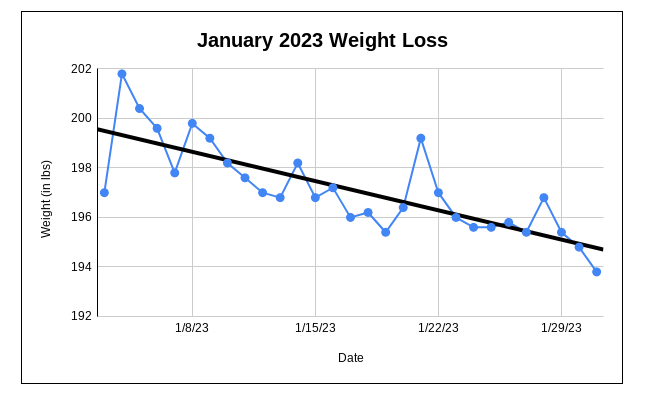Here’s Why Weight Loss Isn’t Linear

Weighing yourself literally makes or breaks your day.
You step onto the scale, adjust your feet just right, and squint one eye in anticipation of a number you don’t like (as if that will somehow soften the blow).
But there it is…
You’re up a pound since yesterday, which just doesn’t make any sense whatsoever.
Just earlier this week, you were down a few pounds!
You feel a sense of frustration start to bubble up underneath your skin.
What’s the point of all this?
Why try so hard if all your effort won’t produce consistent results?
Trust me, I can feel your irritation and discouragement through whatever device you’re reading this on.
I used to get down on myself too when the number on the scale wasn’t what I thought it should be.
I could never understand why, even if you’re counting calories and doing everything right, weight loss could still be all over the place.
But you know what helped put my mind at ease?
Learning about how weight loss truly works.
And once you understand why weight loss works the way it does, you’ll be able to push past all the fluctuations and see the big picture.
In this article, we’ll be discussing why weight loss isn’t linear.
Specifically, you’ll learn about:
- What a normal pattern for weight loss looks like
- Reasons why the scale moves up and down
- Common weight loss myths you shouldn’t be buying into
- What to do if you ever find yourself stuck in a weight loss plateau
What is a normal weight loss pattern?
Some days when your weight is down it’s like, “Hell yeah, all the hard work I’ve been putting in is paying off.”
You do a little happy dance 🕺
And go pose proudly in front of the mirror.
You’re motivated now more than ever to continue eating in a calorie deficit and staying on top of your cardio and strength training workouts.
Other days though, when your weight’s up, it’s like WTF 🤬
Then, there are days when your weight just stays the same.
BUT (and this is really important)…
A normal weight loss pattern has a downward trend.
The key word here is “trend” because weight loss isn’t linear.
It’s more like a zig-zag than anything else.
Here’s what you should be saying and asking yourself:
I know weight loss isn’t linear but month to month, is my weight trending in the right direction?
That’s what matters.
What does a realistic weight loss graph look like?
Words and explanations are cool but if you’re a visual person like me, it’s always better when you have something to look at.
Here’s an example of my weight loss progress from January 2023:

The blue dots represent my daily weigh-ins.
Notice how my weight loss isn’t linear.
It goes down, back up, down, up, and even stays the same for a little bit.
Now, check out the bold black line running through all those blue dots.
That’s the trend line, and as you can see, it’s going down.
That’s what counts, the day-to-day weight fluctuations don’t matter.
As long as your overall, long-term trend is a downward one, that means you’re losing weight and on the right track.
I’m just using myself as an example so please don’t think your weight loss should look exactly the same as mine.
Everyone’s different.
Why does weight loss go up and down?
You get that weight loss isn’t linear.
But why though?
What makes the scale move up and down the way it does?
The scale can be deceiving at times and won’t always be an accurate representation of your progress.
Most fluctuations in weight have to do with water retention.
So if the scale ever says you gained 5 pounds overnight or something like that, know that it’s just from your body holding onto more water.
You didn’t suddenly gain a whole bunch of fat (by the way, there’s a difference between weight loss and fat loss).
Common weight loss myths NOT to buy into
On board with the fact that weight loss isn’t linear?
Sweeeet.
I want you to think about these statements for a second…
You can eat carbs and still lose weight.
Intermittent fasting isn’t some secret hack for weight loss.
Fat burners are useless.
Detox teas don’t boost your metabolism (it’s not broken, just an FYI).
You don’t lose more fat with fasted cardio.
Sweating isn’t an indication of a good workout.
There’s no such thing as starvation mode (aka that whole “not eating enough to lose weight” myth).
I don’t want you to buy into all the fear-mongering B.S. out there.
If any of the statements above go against what you’ve seen online or on social media, make sure you READ THIS POST.
It’ll provide you with some clarity about what’s real and what’s just a bunch of nonsense when it comes to weight loss.
How do you break through a weight loss plateau?
Part 1 of breaking through a weight loss plateau
This is a two-part answer.
The first part starts with a question.
I want you to start by asking yourself: Am I truly in a weight loss plateau?
Be honest with yourself about how consistent you’ve been with maintaining your calorie deficit.
- If you’re binging out every single weekend then there’s no reason to think you’re in a weight loss plateau. You just need to dial things in with your nutrition.
- You’re not in a plateau if you’ve been in a calorie deficit for a grand total of 3.5 seconds.
- If it’s only been a week or two of the scale not budging, I know it can be annoying but you’re not in a weight loss plateau at this point. Remember, weight loss isn’t linear. It can move up, down, and just be all over the place.
Just understanding weight loss isn’t linear is one thing.
But at the very beginning of your fitness journey when weight loss comes easy, that’ll probably be the furthest thing from your mind.
For the first few weeks or couple of months, you’ll probably see pretty consistent weight loss and/or you’ll be losing inches.
But eventually, your progress will start to slow down.
You’ll have some weeks where you don’t see any weight loss at all.
It doesn’t mean you’ve hit a weight loss plateau.
It just means you’re human and experiencing something all of us do…
The law of diminishing returns, which basically just means the more you practice or do a particular thing, the slower your results become over time.
Let’s use increasing your bench press as an example.
When you’re just starting out and applying progressive overload, you’re going to see pretty substantial strength gains workout to workout.
But over time, you won’t keep making those same leaps and bounds with every single workout.
You may start off by adding 5 pounds to your bench each month.
But if you were able to keep things up at that rate, you’d be benching 600 pounds in a few years.
Your bench gains aren’t always going to be linear the same way weight loss isn’t linear.
I know this won’t be the answer you want to hear when it comes to breaking through a weight loss plateau.
You want me to tell you a specific type of food to eat, a secret workout “hack,” or list off a combination of supplements that’ll jumpstart your metabolism.
But that’s not real-life weight loss advice.
If you want to lose weight and finally keep it off for good, you’re going to have to keep on pushing even if you don’t feel like what you’re doing is working, even when the scale isn’t budging or it’s jumping all over the place.
If you can have patience, weather the storm, and remain consistent, the weight WILL come off.
Part 2 of breaking through a weight loss plateau
Are you still CONVINCED you’ve reached a weight loss plateau?
To truly be in a weight loss plateau, that means over the past four weeks:
- You haven’t seen a downward trend in your weight.
AND…
- You’re taking measurements every two weeks and none of them are decreasing.
You can only consider yourself stuck in a weight loss plateau if BOTH (I repeat, BOTH) are happening.
If they are, make sure everything checks out in the following areas:
- Calorie consumption: Are you eating the number of calories you should be for weight loss? Here’s how to figure that out.
- Consistency: You should be at least 80% consistent with hitting your workout and nutrition goals (that’s roughly 24/30 days in a month).
- Accuracy: Are you counting calories to ensure you’re eating the right amount for your weight loss goals? You’re eating more than the 1,200 calories you think you are if you haven’t seen any weight loss. Also, make sure you’re weighing and measuring your food correctly, accounting for all the extra bites, nibbles, and snacks, being on point throughout the whole week, and not just taking weekends off. If things are always falling apart on the weekends for you, consider giving calorie cycling a try.
- Strength training: Are you lifting weights 3-4 times a week and building muscle, which will help you lose fat even when you’re not working out?
- NEAT: This stands for non-exercise activity thermogenesis. In non-science speak, it’s the amount of movement you get throughout the day through activities outside of your workouts, like walking, doing yard work, grocery shopping, etc. NEAT burns more calories (triple the amount, in fact) than your actual workouts do. Aim for between 7,500-10,000 steps every single day.
- Do NOT eat back exercise calories: You shouldn’t be eating back the calories you burn from exercise.
Weight loss isn’t linear wrap up
Is your weight moving all over the place?
No big deal.
Now that you know weight loss isn’t linear, it’s to be expected.
Let the scale move up, down, side to side…Whatever it wants to do.
You don’t have a worry in the world.
As long as your overall weight loss trend is downward one, you’re making progress and on the right track 💪

What's up?
I’m Chad, I’m happy you’re here! I’m a certified personal trainer and my goal is to help you form practical, sustainable habits that lead to lifelong fitness results. If you want to lose fat, build muscle, and live a healthier, happier life then you’re right where you need to be. 💪🏾
Free resources
⬇⬇⬇







0 Comments